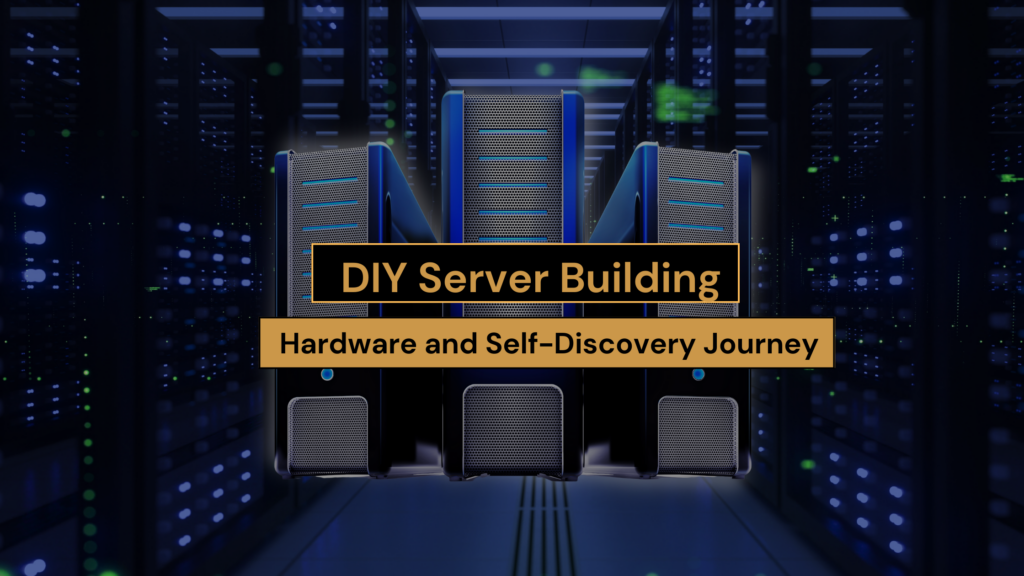As the pandemic hit and remote work became the norm, I found myself with a lot of spare time and a strong desire to create a custom-tailored home environment that suited my needs. And so, my journey began, and was it a wild ride!
Finding the Right Resources: Serverbuilds.net and Discord Community
I was completely clueless about where to begin with building my own server. So, I started doing some research online, reading articles, watching YouTube videos, and stumbled upon the serverbuilds.net YouTube channel, which was run by Logan, aka JDM_WAAAT. Once I checked out their website, I felt like I hit the jackpot of golden information for custom server builds. Their community had great help resources, and I became hooked on binging all their forum discussions.
Their SNAFU guide was one of the best resources I found. It was a comprehensive manual that taught me everything from A to Z about the different components I would need and how to put them together. It even included a visual diagram breaking down all the parts, which was a game-changer for me.
And let me tell you, their SNAFU guide was an absolute lifesaver. It’s a comprehensive manual that covers everything you need to know, from the different components required.. I’m talking about a visual diagram breaking down all the parts, a detailed list of compatible parts related to motherboard, CPU, RAM modules- it’s a one-stop-shop for building a server.
Trust me, once you’re done reading this article, you need to go and check them out.

With all this new knowledge in hand, I knew I had to take the next step and join their Discord server.
It’s a fantastic community of tech enthusiasts who are all passionate about building custom servers, and they share their knowledge and experiences freely.

A Trusted Transaction: Buying Used Parts from a Strange
So, I was just scrolling through the Discord server’s sub-channels, looking for some second-hand server hardware, and that’s when I came across a post from this guy who was selling a whole bunch of server components at a really good price.
And after doing my due diligence and research, I realized that this was the perfect setup for my needs – in fact, it was even more than I needed. So without hesitation, I jumped on the opportunity and reached out to him.
In that was the list:
- X9DRH-iTF motherboard
- 2 E5-2667V2 CPUs
- 8 sticks of 16GB DDR3 ECC ram
- 1 LSI 9211-8i PCIE card
- 2 asetek aio CPU water coolers
My Experience with Dual-Socket Motherboard and IPMI
So, when I first saw the X9DRH-iTF motherboard, I was like, “holy moly, this thing is an absolute powerhouse!” It’s a dual-socket motherboard, which means it can handle not one, but two CPUs! That’s perfect for running multiple virtual machines, which is exactly what I needed for my home lab setup.

But the real kicker? This thing has an IPMI (Intelligent Platform Management Interface) interface built right in. If you’re not familiar, that’s a pretty big deal in the world of server motherboards. It means I can remotely access and control the server hardware, even if the operating system isn’t running or the server is turned off. I’m talking power on/off, reboot, BIOS settings, remote console access, and hardware monitoring – all at my fingertips! And let me tell you, that’s going to be a serious game-changer for troubleshooting, maintenance, and remote management of my server.

The Power Trade-Off: Why I Opted for a Server-Class Motherboard
Now, I know what you’re thinking – “But Juana, isn’t a server-grade motherboard going to use more power than a consumer-grade one?” And yeah, you’re right. It is. But here’s the thing: I’m willing to take that trade-off in power consumption because I wanted the high efficiency and all the cool features that server-class motherboards can offer. I can confidently say it was totally worth it.
Besides, this server isn’t your run-of-the-mill application hosting machine. No, It’s a lab machine – a testing ground for all sorts of experimental projects. And let me tell you, I’ve a lot of cool stuff planned for this server. But here’s the thing – I don’t need it running all the time.
Nope, nope, nope. So, I’m willing to make the sacrifice of not having it plugged in constantly to save on power consumption. It’s not like I’m shutting it down every 5 minutes – just when I know I won’t be using it for an extended period of time. And when I do fire it back up again, it’s ready to go in no time thanks to its speedy boot-up process.
A Trusted Transaction: Buying Used Parts from a Stranger
So, let me tell you, folks, I was in quite the predicament when I stumbled upon this deal. I mean, the parts were exactly what I needed, but the seller was a complete stranger! Can you believe it? But you know what they say – sometimes you gotta take a leap of faith to get what you want.
And let me tell you, after I did my due diligence and checked this guy out, I was ready to take the plunge. I mean, the guy had a solid reputation in the community, and I could pay with PayPal for added protection. It was a no-brainer!
And let me tell you, when those parts arrived at my doorstep, I was like a kid on Christmas morning! They were in pristine condition – I’m talking almost brand new. It was amazing! All that hesitation was worth it in the end.

Once I scored the motherboard and other essential components from the guy I met on Discord, I didn’t stop there.
Oh no, I had to make sure everything was top-notch for my build. So, I turned to my trusty ServerBuilds.net Discord community to help me out with other parts. I needed the right fans, cables, and storage to ensure my server was going to be a beast.
I snagged a few extras from Amazon to complete my build, including cables, connectors, and SSDs. And let me tell you, I spared no expense on the SSDs because I knew performance was going to be key in this project. I even went ahead and got a PCIe card so I could add some M.2 NVMe SSDs to run my virtual machines at lightning speed.
But that’s not all. I stumbled upon a deal on Facebook Marketplace, where I got my hands on three WD Red 4TB NAS-grade hard drives for an unbeatable price.
With my LSI 9211 PCIe RAID controller, I was able to create a beautiful, high-performance storage solution for all my file servers and system backups.
It’s like having my own personal cloud!


Choosing the Right Enclosure
Alright folks, so once I got all of the necessary components for my ultimate server build, the next step was finding the perfect enclosure. And let me tell you, this was no easy task. I live in a small apartment and the last thing I wanted was some bulky, ugly computer tower taking up precious space in my living room. So, I set out on a mission to find a case that was not only functional, but also stylish.
After doing some serious research, I finally decided to go with the Phanteks Enthoo 719 Full Tower case. And let me just say, this case is a beauty!
Not only is it easy on the eyes, but also the specs was just spacious enough to accommodate my entire cooling system without breaking a sweat, and of course because it was part of the SNAFU guide’s list of compatible cases for my motherboard, which gave me peace of mind knowing that it was the right fit for my build.



Overcoming Challenges in Water-Cooling and motherboard installation
One of the most grueling tasks of my build was putting together my water-cooling system. It was a challenge, let me tell you. I had to put on my thinking cap and strategize the best placement for my fans to ensure optimal cooling. And to top it off, the standoff screws and holes within my case didn’t quite match up with my motherboard architecture. But you know what? I got by with a little help from my friend, the guy who sold me the parts. He gave me some killer advice and shared his own struggles when he installed the board. Gotta love that community spirit, right?




My Hypervisor OS of choice
Ah, the moment of truth: installing the hypervisor! After much research, I decided to go with Proxmox OS – an open-source platform that can handle a variety of virtualization technologies like KVM, LXC, and OpenVZ. And let me tell you, the installation process was smoother than butter on a hot skillet. It was so easy, it almost felt like cheating.

Final Thoughts
Let me tell you this, building my own server was a game-changer. I learned so much about hardware and was able to create a powerhouse machine tailored specifically to my lab’s needs. Now, I can easily swap out components as needed and know that my server can handle any workload I throw at it.
I’m not gonna lie, the process was a lot of work, but seriously , was it worth it. Every time I walk into my living room and see that amazing server humming away, I feel like a boss. Yeah, it might be nerdy, but who cares when you have a beast of a machine like this?

If you’re thinking about taking the plunge and building your own server, I say go for it. Just be prepared for a lot of research, hard work, and money, but trust me, the feeling of accomplishment at the end is priceless.


